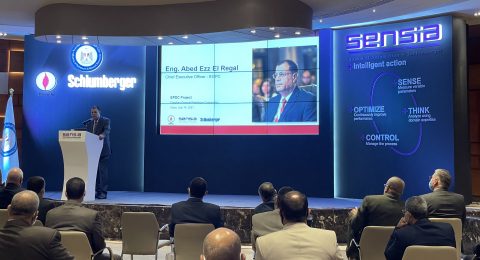Over the years, operators drilling offshore and onshore in the Nile Delta area have searched for a high-performance water-based fluid (HPWBF) that can replace oil-based fluids and exhibit the same characteristics. Recently a new HPWBF has been introduced to the area that has helped close this gap.
The gas fields in the Nile Delta region are critical to Egypt’s plans for improved production and future development. The Mediterranean area is by far the biggest gas producer in Egypt, accounting for 60% of the country’s proven reserves. Wells drilled in that area are located onshore, in the middle of Egypt’s most important agricultural area, or offshore in the Mediterranean Sea (Figure 1). In either case, environmental regulations make the development and implementation of a HPWBF increasingly important.

Figure 1: Nile Delta Offshore and Onshore Region
This new fluid was actually introduced to the area when it was used to drill an ultra-deep, high pressure-high temperature (HPHT) well offshore the Nile Delta region of the Mediterranean Sea. The well presented several issues: reactive shales, high temperatures and densities, narrow margins between pore pressure and fracture gradient, the risk of lost circulation, and an environmentally-sensitive location. The numerous challenges presented provided a good opportunity to put this system to the test.
Factors for Customized Fluid Design
Several important criteria went into the design of the proprietary fluid system. The desired performance characteristics included improved wellbore stability, superior shale inhibition and the encapsulation of drilled solids. The fluid was required to demonstrate stable rheological properties at high temperatures and provide good control over equivalent circulating density (ECD). Minimizing environmental impact was the other key concern. The new fluid would need to meet or surpass the environmental compliance standards for drilling in the Gulf of Mexico and offshore Brazil.
Extensive design work and testing resulted in a non-dispersed, clay-free WBF that can provide maximum shale stabilization in highly reactive clays. The fluid utilizes ions such as chloride, sodium and/or potassium to suppress clay hydration through ionic replacement and by decreasing the activity of the fluid/formation water exchange. Chemical thinners or dispersants are not used. Instead, polymeric flocculants and encapsulators are employed along with inhibiting amines to prevent clay from dispersing in the system. This prevents the breaking up of drill solids into smaller particles and improves the efficiency by which the solids control equipment (SCE) can remove them.
The three key polymers of the system perform the following functions:
1. A high molecular weight polymer is effective at low concentrations to flocculate and encapsulate reactive clay drill solids as they are drilled. As a result, colloidal clay is easily removed by the solids control equipment. The polymer can dramatically reduce solids accretion on bit and bottomhole assembly (BHA) while drilling reactive formations (Figure 2).

Figure 2: BHA pulled from well drilled with the low-solids, non-dispersed WBF fluid shows no accretion after exposure to reactive clay.
2. A low molecular weight polymer inhibitor prevents hydration and disintegration of clay-rich formations.
3. An amine-based polymer provides extra inhibition for illitic clay material. It attaches to electron-deficient or partially positive charges.
Introducing this fluid to such an important project required a field trial to confirm lab data prior to the actual application of the fluid on this specific well. The successful trial was performed on a development well that was drilled in the same area.
The resulting success story involved drilling approximately 1600 meters of notoriously reactive shale sections of the Mediterranean Sea, inter-bedded with occasional sand stringers, using a low-maintenance, water-based drilling mud. The mud weight was as high as 2.25 sg at a bottomhole temperature reaching 300ºF. Under these conditions the fluid provided excellent equivalent circulating density (ECD) control, trips were performed problem free, and no excessive torque or drag was observed at any time while tripping or running the liners.
The unique polymer package in this new WBF, the first of its kind in the drilling fluids industry, provided almost instantaneous inhibition of highly reactive clays. Non-productive tripping time to clean the bit and BHA was virtually eliminated.
No commercial clays were added to this true low-solids system. Maintaining a low solids content can help enhance rates of penetration. Some operators have reported drilling rates comparable to nearby offsets drilled with synthetic-based fluids. The development of a water-based fluid that can replace oil-based fluids while providing equivalent drilling performance has been an industry priority for a long time. Further study and optimization of the WBF system will help bridge any remaining performance gaps.
Further Development
The promising results obtained allowed for further development of the new fluid system. The HPWBF was selected to drill through the Kafr El Sheik shale formation, a very reactive young shale which is present at a shallower depth. To make the situation more complicated, the hole sizes involved were much larger and had higher penetration rates and deviation angles, than the deep HPHT well described above. Historically the Kafr El Sheik shale was always drilled with an oil-based fluid and earlier attempts to use a water-based fluid were generally unsuccessful.
Again, extensive lab testing was involved and the results indicated that an actual well trial would be successful. Adjustments to the fluid formulations were also made to accommodate the new wellbore conditions. This allowed testing of the adaptability of this new fluid to different down hole conditions. The uniqueness of the polymer package was demonstrated here by the effect of adjustments made to concentrations of the different polymers and the excellent results that were obtained.

Figure 3: Kafr El Sheik Shale Adherence Comparison
Both onshore and offshore wells were drilled to the interval total depths with minimal issues. The results indicate that we have moved much closer to achieving the performance of oil-based fluids. Further, the outcome of these field trials has initiated similar projects in other areas of Egypt that may eventually lead to use of the HPWBF in the environmentally-sensitive Gulf of Suez area of the Red Sea.
By Ahmed Ebeid- Technical Advisor at Baroid Fluids Division, Halliburton







